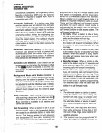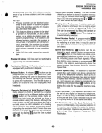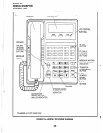
STRATA DK
GENERAL DESCRIPTION
DECEMBER 1990
Features, Day/Night Mode, for a defini-
+-- tion of these ringing modes. If the sys-
tem has tenant service, then the DDSS
and/or DSS consoles specified for the
second tenant have independent control
over ringing modes. The
q
button is
pre-assigned and must be button 60.
l
Speed Dial: Pressing an
q
button
dials a telephone number automatically.
Voice or Tone Signaling: DSS and DDSS
consoles may be programmed for voice- or
tone-first signaling, independent of the sys-
tem’s assignment. As with all stations, the
DSS or DDSS console attendant may
choose the alternate mode at any time.
See Voice or Tone Signaling.
Call Forward Override: Either the
DSSDDSS console or its associated tele-
phone can be programmed to call stations
even when the station has call forward set.
This allows attendants to notify users that
may have forgotten their telephones are in
the call forward mode.
DISA Security Code Revision: To ensure confi-
dentiality, only stations selected in program-
ming can set, change, or cancel the DISA
security code (1 N 15 digits).
Distinctive LED Indications: A station or CO
Line LED flashes distinctively to indicate differ-
ent states:
Exclusive Hold and CO Line Confer-
ence: Lines that are placed on exclusive
hold or are on a conference call will flash
at double the on-hold rate (see Exclusive
Hold).
Incoming Call: An LED flashes distinc-
tively at the called station.
In-use: Other stations see a steadily lit
LED, and the LED on the in-use station
flashes distinctively.
-42-
On-hold: Other stations see a distinctive
on-hold flash. The used station’s LED
flashes at a special on-hold rate.
Distinctive Station Ringing: System-wide, CO
lines and intercom lines ring differently from
*Available using standard or electronic telephones.
each other, as described in System Features,
Distinctive CO Line/intercom Ringing. Elec-
tronic telephone stations in close.proximity can
be programmed to ring differently. This allows
station users whose phones are near each
other to easily distinguish between their
incoming CO line calls. Two different tones are
available for incoming CO line calls:
l
Tone 1: 5001640 Hz, modulated by 16 Hz
l
Tone 2: 600/800 Hz, modulated by 16 Hz
Do Not Disturb: When a station user does not
want to be disturbed, the w button can be
pressed, and users calling that station will get
a fast busy signal.
Do Not Disturb Override*: A privileged user,
by dialing a 1, can send a tone to a station that
is in the do not disturb mode. DND override
cannot be blocked for selected stations.
DP/DTMF Mode Change*: Allows a station to
change CO out-dialing signal modes from dial
pulse (DP) to DTMF (or vice versa) by press-
ing the m button.
,
Exclusive Hold: A station user can press the
m button twice to hold a call and not allow
it to be picked up by any other party whose
station has the same CO line appearance.
Exclusive hold calls can be picked up with the
remote retrieval of held calls feature, although
the party picking up the call must know it is
there (no LED indication of a holding call is
given to any station except the station originat-
ing the exclusive hold).
Executive Override*: A privileged user can
enter any conversation in the system by dial-
ing 8. An optional warning tone sounds to noti-
fy conversing parties that an additional party is
about to enter the conversation.
NOTE:
Executive override can be blocked selec-
tively to any station in system programming.
This provides security fo.r modem (data)
calls, voice mail calls, fax calls, etc.


















